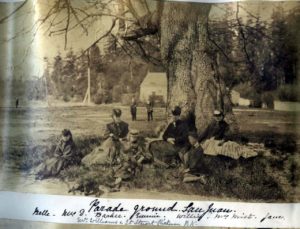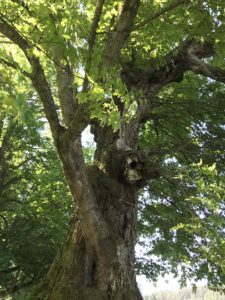One of the really interesting things about moving all over the country is learning the different kinds of plants in the parks. Guests expect the rangers to know what all the plants are, so we learn them as best we can. There are three unusual trees here on San Juan Island that I have not encountered anywhere else.
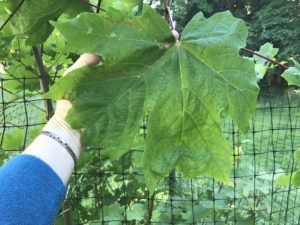 The first of the unusual trees is the Big-Leaf Maple. The Big-Leaf Maple is distinguished by its big leaves which average 12 inches across. Each leaf is bigger than my hand. The Big-Leaf Maple is the most common tree found in the Pacific Northwest. Traditionally Big-Leaf Maple wood is used for fine woodworking such as cabinets. The Coast Salish made canoe paddles out of this wood and called it “the paddle tree.”
The first of the unusual trees is the Big-Leaf Maple. The Big-Leaf Maple is distinguished by its big leaves which average 12 inches across. Each leaf is bigger than my hand. The Big-Leaf Maple is the most common tree found in the Pacific Northwest. Traditionally Big-Leaf Maple wood is used for fine woodworking such as cabinets. The Coast Salish made canoe paddles out of this wood and called it “the paddle tree.”
We have a Big-Leaf Maple tree on the ground of English Camp that is 350 years old. At one time it was the largest Big-Leaf Maple in the world, but a couple of branches broke off in 1969 and it lost that status. It is still a huge old maple and people enjoy sitting in its shade for picnics. We have a picture of the Delacombe family – Captain Delacombe was the second commander of English Camp – sitting under this maple tree in 1868.
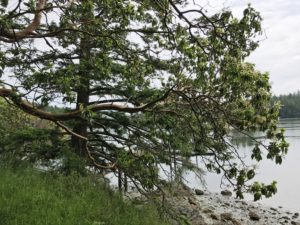
The second of the unusual trees is the Pacific Madrone. This tree is unusual because it has a very smooth, cinnamon colored bark. The branches also grow more horizontally than they do vertically. Some arborists call it “the contortionist tree.” We have Madrone trees here that start 30 feet into the woods but grow horizontally until they rest on the ground. When you see them, you think something must have bent the branches, but they do this naturally.
The Madrone is an evergreen that has leaves similar to a rhododendron. In the spring it has lovely white flowers that later turn into red berries. Because of its bark, it stands out in a woods no matter what the season.
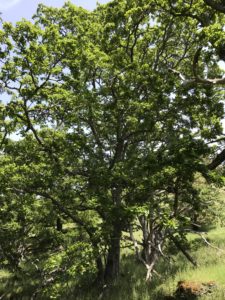
The final of the unusual trees is the Garry Oak, also known as the Oregon White Oak if you are in Oregon. This large oak tree only grows in coastal prairies. Unless the area remains prairie by a controlled burn, the Garry Oak will lose its habitat to the Douglas Fir. Native Americans collected the acorns and set fire to the habitat regularly to maintain the Garry Oak. The National Park Service maintains a small area on Youngs Hill where the Garry Oak lives by doing regular prescribed burns.
Garry Oaks are not as noticeable as the Big-Leaf Maple or Pacific Madrone but they have an important niche in the habitats of the northwest. Wild animals eat the acorns and the Marble Island Butterfly – which I will discuss in a future post – and band-tailed pigeon use the Garry Oak for their homes.
Learning the plants in a specific area is an important part of our jobs. These three unusual trees have been easy to learn and we talk about them regularly with our guests. They are part of the distinctive habitat of the Pacific Northwest.

